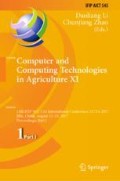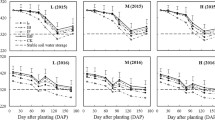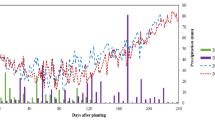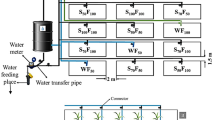Abstract
In this study, the maize was selected as test crops, the effects of irrigation times, planting density and fertilization amount on maize morphology and yield under drip irrigation under film were discussed and compared with ridge irrigation. The results show that: Comprehensive irrigation times and planting density, the largest yield are 8426.4 kg/hm2 under irrigation 3 times. For the case of fertilization, given the planting density of 5500 plants/mu, irrigation 4 times, the amount of fertilizer as a variable, when the fertilizer rate of 450 kg/hm2, the maximum yield is up to 9162 kg/hm2. The yield and water production efficiency of drip irrigation under film were significantly increased by 32.9%, 18.0% and 42.5%, respectively, under the same irrigation amount, water production efficiency increased by 34.9%, 6.0%, 33.3%.
You have full access to this open access chapter, Download conference paper PDF
Similar content being viewed by others
Keywords
1 Introduction
Drip irrigation technology is based on drip irrigation under film technology developed by the efficient water-saving technology, with the advantages of both [1, 2]. In recent years, drip irrigation technology under the scope of the application is no longer limited to fruits and vegetables, cotton, greenhouse and other economic crops, maize and other field crops are also widely used under the membrane drip irrigation technology. The plant height, leaf area, stem diameter and yield of maize were obtained under the condition of lower limit of water holding capacity in different fields under different conditions [3]. The irrigation quota had a great effect on the physiological traits and yield of maize under drip irrigation under film. Under the condition of drip irrigation, the irrigation quota was suitable at 5250 to 6000 m3/hm2 [4]. The soil water content of maize under drip irrigation was always higher than that of conventional irrigation, the yield of maize under drip irrigation increased with the increase of irrigation amount [5]. The use of drip irrigation under film of field irrigation will make maize yield more than 12%, saving water about 40% [6]. Under different drip conditions, different spacing treatments have great effects on maize growth characters and maize yield [7]. In this paper, four test variables were designed to explore the effects of irrigation times, planting density, and fertilization amount and irrigation quota.
2 Test Materials and Methods
2.1 General Situation of the Test Area
Yanggao County was located in the northeastern of Shanxi Province, longitude between 113°29′ and 114°6′ and latitude from 39°50′ to 40°31′. Altitude reached 1017 to 1030 m, groundwater depth of 1 to 2 m. The average annual temperature of 7.1°C, the annual frost-free period 102 to 130 days, the average annual precipitation of 413 mm, the average annual evaporation of 1743 mm, wind speed 3 m/s, permafrost depth of 1.43 m. Soils are cultivated with sulfate of salination meadow soil, and soil texture above 3 m is sandy loam and light loam. The organic matter content is 13.9 mg/kg, total nitrogen is 0.67 mg/kg, available phosphorus is 5.4 mg/kg, available potassium is 85 mg/kg, Alkali-hydrolyzed nitrogen is 165 mg/kg, total salt content in shallow water is 0.644%, well water is 0.3%, bulk density is 1.4 g/cm3, PH value is 8.1, lower fertility level.
2.2 Test Design and Treatment
The drip irrigation times were as follows: 3 times (jointing, heading and Grouting), 4 times (jointing stage 1times, heading period 2times and Grouting 1 times), 5 times (jointing 1times, Heading date 2times, Grouting 2times), irrigation quota 225 m3/hm2. The drip irrigation under film planting density: selection for suitable planting varieties Limin 33, 5000 plants/mu, 5500 plants/mu, 6000 plants/mu. The amount of fertilizer applied to drip irrigation under film was divided into three levels: normal amount 450 kg/hm2; increase 50%, 675 kg/hm2; decrease 50%, 225 kg/hm2. Ground ridge irrigation, irrigation quota and drip irrigation corresponding to three levels: 675 m3/hm2, 900 m3/hm2, 1125 m3/hm2. According to the test factors and levels, the experimental field is divided into four districts and 12 treatments, each dealing with two replicates, a total of 38 districts (Fig. 1), the seeding form of “a membrane with two rows of maize”, the film maize spacing is 40 cm and the two films is 60 cm.
A0, A1, A2 and A3 indicate the number of drip irrigation is 0,3,4,5 times and the irrigation quota is 225 m3/hm2. B1, B2 and B3 indicate the planting density of maize is 5000 plants/mu, 5500 plants/mu and 6000 plants/mu, and C1, C2 and C3 indicate that the planting density is in the case of B2, and the irrigation quota is 675 m3/hm2, 900 m3/hm2, 1125 m3/hm2 respectively. D1, D2 and D3 are shown in the case of A2B2, the amount of fertilizer applied to the normal amount of 450 kg/hm2; an increase of 50%, 675 kg/hm2; reduced by 50%, 225 kg/hm2. CK means that the local habit of planting patterns: varieties of XianYu 335, planting density of 4000 plants/mu, covering film, ridge irrigation. Fertilizer in the base fertilizer for the compound fertilizer potassium nitrate, potassium, phosphorus and potassium were 24%, 6%, 10%, topdressing urea, nitrogen content of 40%, with irrigation for fertilization.
3 Results Analysis
3.1 Effects on the Plant Height of Maize Under Drip Irrigation Under Film
Plant height, which can reflect the nutritional conditions of plant, is one of the important indicators of plant growth. This study began to observe the early stages of maize, until the early stages of maturity. Four different planting densities were selected, and the trend of plant height with the growth period was plotted (Fig. 2).
It can be seen from Fig. 2 under the same irrigation conditions (4 times irrigation), different planting density of plant height is small. The plant height increased with time, and reached the maximum at the end of July.
Figure 3 shows the plant growth density of 5500 plants/mu when the different irrigation rate of plant height with time curve. As can be seen from the figure, in early July before the plant height increased with time, then stop increasing. Among them, the plant height was the highest at 3 times, and the plant height was the lowest at 5 times, the plant height of 0 times and 4 times irrigation was centered. It is Indicate that the effect of irrigation on plant height was not obvious.
3.2 Effects of Drip Irrigation Leaf Area Index on Maize
-
(1)
Effects of planting density on leaf area index of maize under drip irrigation
Figure 4 shows the change of leaf area index of maize with three different planting densities under no irrigation, three irrigation, four irrigation and five irrigation conditions. As can be seen from Fig. 4a under the condition of 0 times, the leaf area index of 5500 plants/mu was the largest, the leaf area index of 6000 plants/mu was the smallest, and the leaf area index of 5000 plants/mu was centered. The leaf area index under the three planting densities showed a trend from small to large and then smaller, and reached the maximum at the end of July and its value at 5.5.
Figure 4b, c and d shows the change of leaf area index of maize with three planting densities under irrigation conditions and irrigation times. It can be seen from the figure, in the 3, 4, 5 times irrigation conditions, the leaf area index of 5500 plants/mu planting density was largest, 6000 plants/mu was the second, 5000 plants/mu planting density was minimum, consistent with 0 irrigation results. From the end of July to the end of August, the leaf area index under the condition of 5500 plants/mu planting density was in the range of 5.4–5.7.
-
(2)
Effects of fertilization on leaf area index of drip irrigation under film
Figure 5 shows the change of leaf area index of maize under the conditions of three fertilization levels with planting density of 5500 plants/mu. It can be seen from Fig. 5 that leaf area index with the amount of fertilizer changes (fertilizer changes in the range of 225 kg/hm2 to 675 kg/hm2) very small. The trend is consistent with the above, and at the end of July to the end of August at the maximum period, the value between 5.6 and 6.2.
-
(3)
Effects of irrigation times on leaf area index of maize under drip irrigation
Figure 6 shows the leaf area index versus time curve for different irrigation rates at 5500 plants/mu. As can be seen from the figure, before the end of July, the leaf area index continued to increase with time, followed by a smooth period, to the end of August began to decrease until the harvest period. The leaf area index was the highest, and the leaf area index of the fifth irrigation was the smallest and the leaf area index of 0 times and 4 times was centered. It is Indicate that the number of irrigation has a certain impact on the leaf area index.
3.3 Effects of Maize Yield Under Drip Irrigation of Film
Figure 7 shows the crop yield histograms for different planting densities and different irrigation times in 2015. It can be seen from the figure, 5500 plants/mu planting density of the largest yield, 5000 plants/mu planting density followed, and 6000 plants/mu planting density minimum. Under the same planting density, the yield of 0 times irrigation was the lowest, and the yield of the other irrigation was not changed. Planting density of 5500 plants/mu, the third irrigation yield the largest, followed by irrigation 4 times, 5 times the smallest; the fourth irrigation yield the largest, followed by irrigation 3 times, 5 times the smallest. 6000 plants/mu, the third irrigation yields the smallest, 4 times irrigation and 5 times was little difference.
3.4 Comparison of Drip Irrigation Under Film and Ridge Irrigation Under Film
The treatment of drip irrigation under the film planting density of 5500 plants/mu, irrigation 3 times, 4 times, 5 times and the ridge irrigation 675 m3/hm2, 900 m3/hm2 and 1125 m3/hm2 were compared.
As can be seen from Table 1, the use of drip irrigation under film has obvious advantages than the ridge irrigation under film. Its yield and water production efficiency have improved significantly. Under the same irrigation amount, the yield of film drip irrigation increased by 32.9%, 18.0% and 42.5% respectively, and the water production efficiency increased by 34.9%, 6.0% and 33.3% respectively.
4 Conclusion
The experimental analysis shows that: under the conditions of same irrigation times, single plant dry matter weight of planting density of 6000 plants/mu is the smallest, 5500 plants/mu is the largest. Comprehensive irrigation times and planting density, the largest yield is 8426.4 kg/hm2 under irrigation 3 times. For the case of fertilization, given the planting density of 5500 plants/mu, irrigation 4 times, the amount of fertilizer as a variable, when the fertilizer rate of 450 kg/hm2, the maximum yield is up to 9162 kg/hm2. The yield and water production efficiency of film drip irrigation were significantly increased by 32.9%, 18.0% and 42.5%, respectively, under the same irrigation amount, water production efficiency increased by 34.9%, 6.0%, 33.3%.
References
Xie, X.L.: Study on water requirement and yield effect of drip irrigation maize under membrane. Gansu Agricultural University, Lanzhou (2007)
Xu, J., Zhao, J.H., Huang, H.J., et al.: Effects of different irrigation quota on growth and development of maize under drip irrigation. Water Sav. Irrig. 1, 28–32 (2017)
Lv, D.G.: Effects of film mulching and dripping on maize growth index, water consumption and yield. Water Sav. Irrig. 11, 40–43 (2015)
Tang, G.G., He, H., Yang, J.Y., et al.: Effects of irrigation quota on physiological characters and yield of maize under drip irrigation. Study Soil Water Conserv. 3, 293–297 (2014)
Guo, W.: Experimental study on drip irrigation under wheat membrane in Heilongjiang Province. Northeast Agricultural University, Harbin (2010)
Hou, J.Y., Chen, W.C., Li, F.H.: Butterfly drip irrigation technology with significant benefit of water saving and yield. Water Resour. Hydropower Eng. 4, 296–298 (2007)
Wang, J.: Study on yield and benefit of drip irrigation under maize film. Shanxi Agricultural University (2016)
Author information
Authors and Affiliations
Corresponding author
Editor information
Editors and Affiliations
Rights and permissions
Copyright information
© 2019 IFIP International Federation for Information Processing
About this paper
Cite this paper
Shen, H., Wang, Y., Fan, X., Wang, H., Li, Y. (2019). Effects of the Factors on Maize Yield Under Drip Irrigation Under Film. In: Li, D., Zhao, C. (eds) Computer and Computing Technologies in Agriculture XI. CCTA 2017. IFIP Advances in Information and Communication Technology, vol 545. Springer, Cham. https://doi.org/10.1007/978-3-030-06137-1_43
Download citation
DOI: https://doi.org/10.1007/978-3-030-06137-1_43
Published:
Publisher Name: Springer, Cham
Print ISBN: 978-3-030-06136-4
Online ISBN: 978-3-030-06137-1
eBook Packages: Computer ScienceComputer Science (R0)












